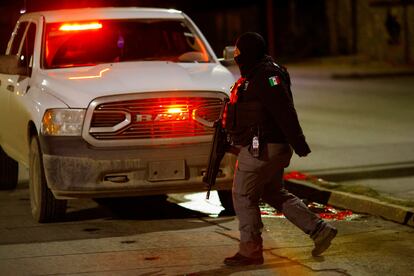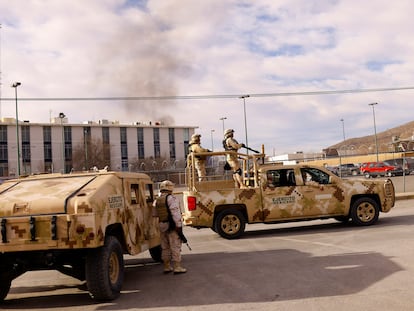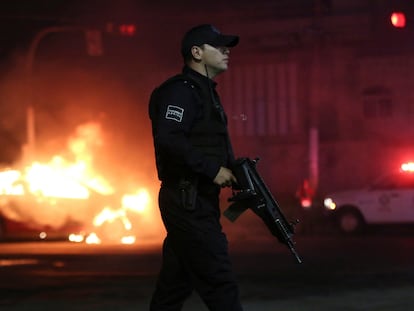Government corruption breeds criminal impunity in Mexico’s prisons
Powerful inmates manage their violent criminal enterprises while living in comfortable cells


“Violence in Ciudad Juárez is like a river that sometimes overflows its banks,” said criminologist Oscar Máynez Grijalba. On August 11, the river of violence overflowed when a riot in the Cereso No. 3 state prison spread into the city streets leaving 11 dead and numerous burned-out businesses. Everyone knew that the order had come from inside the prison, where Ernesto Alfredo Piñón de la Cruz (alias “El Neto”) – the Mexicles gang leader – was locked up. Even María Eugenia Campos, the Chihuahua state governor, put the blame on El Neto. Campos once told the news media that homicides dropped after El Neto was imprisoned last February. But the river overflowed again on January 1, and it started in Cereso No. 3. An armed attack from the outside the prison and a riot inside caused 17 deaths. Thirty prisoners escaped in the tumult, including El Neto, his third escape attempt. Máynez says that El Neto “had no reason to be in that prison, and should have been incarcerated in a maximum security federal prison.” Everyone agrees, but some prisoners in Mexico can do as they please.
Top Mexican security officials said they discovered 1.7 million pesos ($88,000) and several kilos of drugs in the cells of the escaped prisoners. They also found flat screen televisions, safes, long guns, ammunition, and bulletproof vests – all the things they usually find during raids on drug traffickers. Criminals rule the prisons and control the violence beyond the walls. “States and municipalities don’t have the capacity to challenge the criminals; a federal security strategy is needed, but there isn’t one. They bring weapons, drugs, women and musicians into prisons all over Mexico,” said Máynez, who is also a professor at the Autonomous University of Ciudad Juárez.
Máynez is alluding to what is called the narco-state – the web of corruption and bribery that entangles police, officials, politicians, judges and criminals. There is enough money for everyone, and no one can get out of the business, even if they wanted to. As the saying goes, plata o plomo – bucks or bullets. El Neto was not in a high-security prison for a simple reason. Any attempt to transfer criminals out of lower security prisons is violently resisted, or they get legal injunctions from judges to halt the transfers. Bucks or bullets. In June 2021, former Chihuahua Governor Javier Corral requested the transfer of El Neto and other high-level criminals to a federal prison. “These are lengthy processes that require a lot of official paperwork and legal resources. The criminals usually obtain court orders blocking the transfers from some very corrupt judges,” said Corral, who had to enlist the help of former Supreme Court President Arturo Zaldívar to clear up the logjam of court orders. Corral follows El Neto’s activities closely because the criminal has made three attempts on his life that left Corral’s bodyguards badly wounded. Corral says El Neto’s escape is his third attempt. “The first time he tried was when he was being transported to a court hearing. There was a gun battle and a bullet hit him in the head, but he survived.” Corral blames the current Chihuahua administration for letting his prisoner transfer requests die on the vine. “The August 11 prison riot happened, and they didn’t lift a finger. There must be a lot going on behind the scenes. The state prosecutor and the prison director should have been fired for that riot,” said Corral.
Alejandro Alvarado, the Cereso No. 3 prison director, was dismissed after the January 2 violence, and urgent prisoner transfers and investigations were initiated. “The director should have been arrested, not dismissed,” said Corral, who is openly feuding with his successor, Governor María Campos. Both belong to the National Action Party (PAN), although Corral has announced that he intends to leave the party. When the fires were put out and the shooting stopped, all the embarrassing details of what was going on in the prison were exposed, forcing authorities to admit that the situation was unacceptable. Chihuahua State Prosecutor Roberto Fierro Duarte acknowledged the serious prison corruption problem in a press conference on January 3. “We cannot hide the obvious,” he said. When pressed by journalists about why no one knew what was going on in the prison, he sidestepped the question by replying, “It’s not a question of knowing or not knowing.” And then he laid the blame for the prison disaster on the previous administration.
There are 3,901 inmates incarcerated in Cereso No. 3, far more than the prison was designed to hold. There’s a little more room now that 30 inmates have escaped and another seven died in the riot. While most inmates in Mexican prisons endure extreme overcrowding, others live like royalty. Not long ago, a group of inmate relatives went to Mexico City to demand a prison transfer for Abigael González Valencia (alias El Cuini), the right-hand man and brother-in-law of cartel boss, Nemesio Oseguera Cervantes (alias El Mencho). The family members of the inmates at Santa Martha Acatitla prison say that El Cuini lives a privileged existence while everyone else suffers in deplorable conditions.
When Corral was governor of Chihuahua, it was common knowledge that violence in the streets of Ciudad Juárez “was orchestrated by cellphone from within the prison.” The former governor says a massive operation to end this was thwarted by internal leaks and incited a rabid reaction from the criminals. “They shot up the Municipal Security offices, burned trucks and executed people. The operation did not produce the outcome we wanted,” said Corral. The state government then decided to build a $2 million high-security module in Cereso No. 3. “It’s a four-story building surrounded by a perimeter fence, with cell monitoring technology, automatic doors and locks, and security cameras. It can hold 46 inmates,” said Corral, who says he told incoming governor María Campos that it was “an important asset for transferring criminals.” Corral later accused Campos of taking credit for building the high-security facility in her first official report as governor. Moreover, the facility “was never used because the criminals haven’t allowed it,” said Corral.
It’s tough to find out whether the high-security facility in Cereso No. 3 is housing any prisoners, says Rocío Gallegos, because “journalists aren’t allowed to enter the jails.” Gallegos, the editorial director of the La Verdad news outlet in Ciudad Juárez, said: “The criminals openly defy the police and the government. We saw that after the August riot, when the prison director was forced to resign, and an investigation was initiated. Just like now. But there were no consequences or transparency back then. This was a prison escape foretold,” she said. When criminals are arrested on the streets, they all say the orders come from within the prison. It’s also well-known that the bosses enjoy “different” living conditions, as occasionally reported by the Ministry of National Defense (SEDENA).
Top criminals control the smaller prisons and perhaps the federal prisons as well. Oscar Máynez doesn’t know what’s happening with the Cereso No. 3 high-security module, but he doesn’t discount the possibility that inmates have refused to be transferred there. “Sometimes they make a show of transferring inmates there and take pictures. But later they are transferred out again,” said Máynez. Nothing is strong enough to oppose the narco-state, “which is exactly what we have, even if they don’t want to admit it. The battle against violence is a farce and our laws are useless. Politicians get beaten down if they try to attack money laundering.”
Ciudad Juárez is a border city. Weapons from the United States enable the city to operate the most lucrative businesses in the world: drugs, migration, prostitution and human trafficking. There is enough money for everyone. Oscar Máynez doesn’t think the escaped prisoners will venture very far because they can’t go to the United States or other parts of Mexico without running into rival gangs. “This will make it easier to recapture them.” Then they will go back to jail, turn on the TV, snort some coke and party with their favorite bands. Orders will be dispatched by cellphone and the river of violence will subside for a while.
Sign up for our weekly newsletter to get more English-language news coverage from EL PAÍS USA Edition
Tu suscripción se está usando en otro dispositivo
¿Quieres añadir otro usuario a tu suscripción?
Si continúas leyendo en este dispositivo, no se podrá leer en el otro.
FlechaTu suscripción se está usando en otro dispositivo y solo puedes acceder a EL PAÍS desde un dispositivo a la vez.
Si quieres compartir tu cuenta, cambia tu suscripción a la modalidad Premium, así podrás añadir otro usuario. Cada uno accederá con su propia cuenta de email, lo que os permitirá personalizar vuestra experiencia en EL PAÍS.
¿Tienes una suscripción de empresa? Accede aquí para contratar más cuentas.
En el caso de no saber quién está usando tu cuenta, te recomendamos cambiar tu contraseña aquí.
Si decides continuar compartiendo tu cuenta, este mensaje se mostrará en tu dispositivo y en el de la otra persona que está usando tu cuenta de forma indefinida, afectando a tu experiencia de lectura. Puedes consultar aquí los términos y condiciones de la suscripción digital.
More information
Archived In
Últimas noticias
Most viewed
- Reinhard Genzel, Nobel laureate in physics: ‘One-minute videos will never give you the truth’
- Oona Chaplin: ‘I told James Cameron that I was living in a treehouse and starting a permaculture project with a friend’
- Pablo Escobar’s hippos: A serious environmental problem, 40 years on
- Why we lost the habit of sleeping in two segments and how that changed our sense of time
- Charles Dubouloz, mountaineering star, retires at 36 with a farewell tour inspired by Walter Bonatti










































